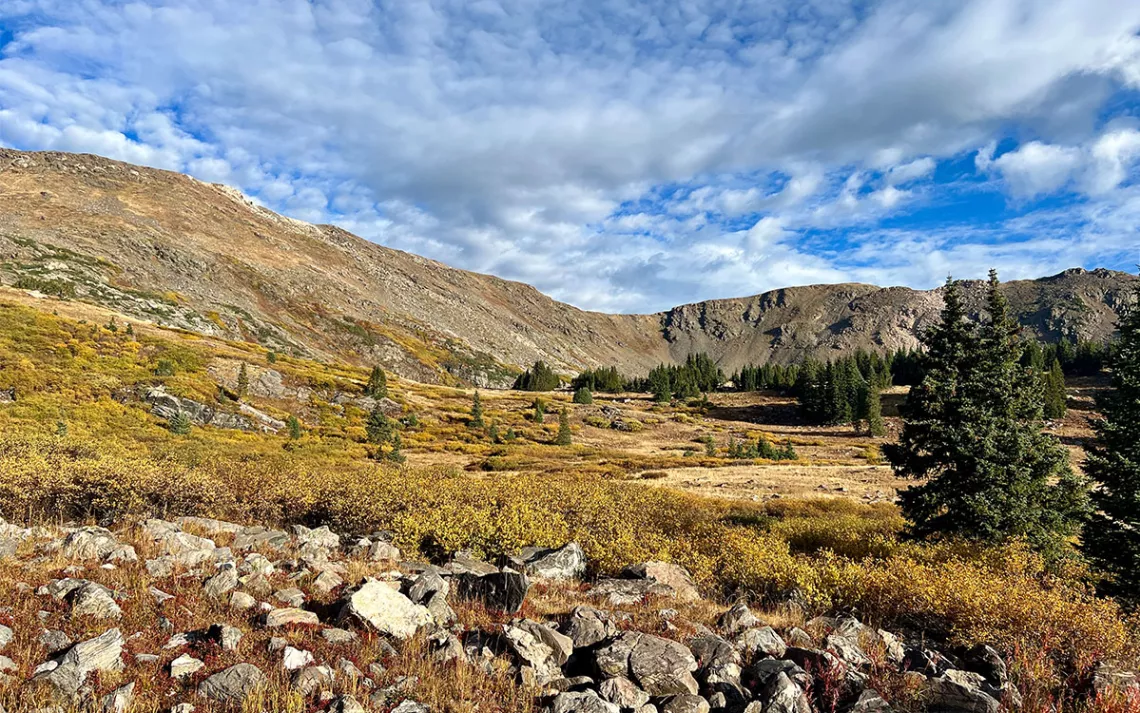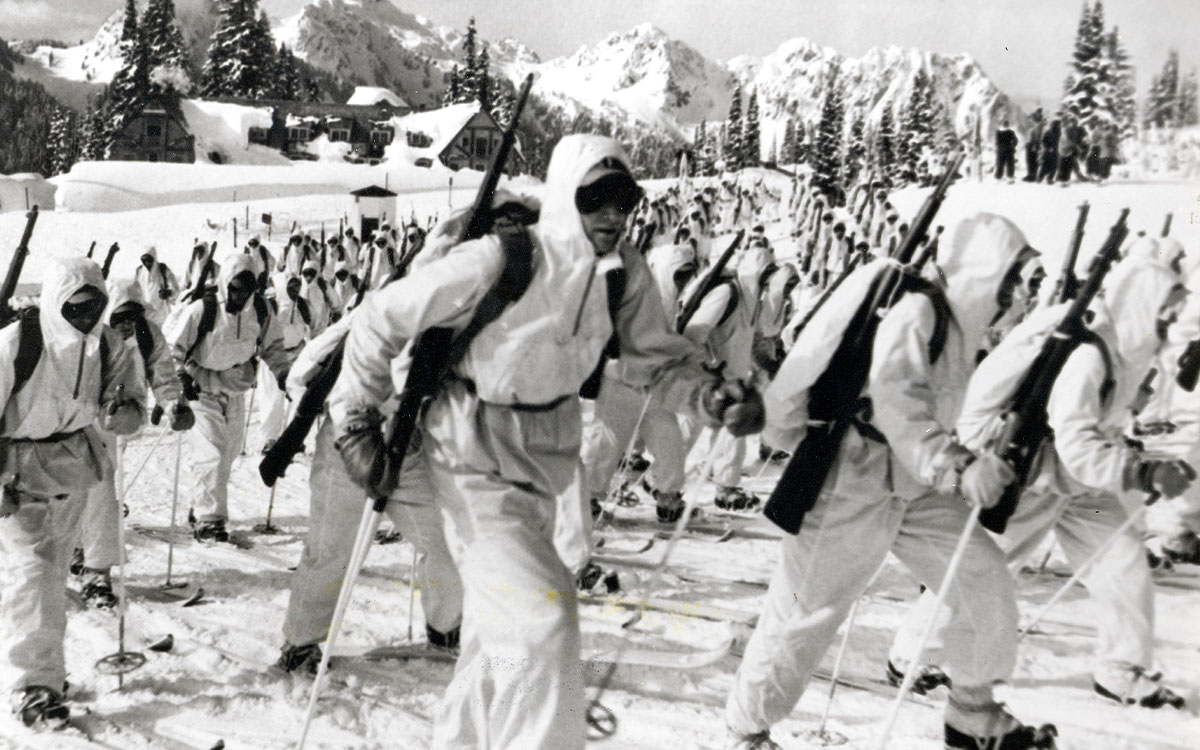In the Footsteps of the 10th Mountain Division
From the Greatest Generation to the Glamping Generation? A visit to one of America’s newest national monuments.

Golden willow bushes blanket a subalpine meadow at the foot of Homestake Peak. | Photo by Gina DeCaprio Vercesi
It was a sunny morning in late September and I was nearing the summit of Homestake Mountain, a classic 13er (i.e., a mountain in the 13,000-foot range) that straddles the Continental Divide in the central Colorado Rockies. I’d never hiked at this altitude before, and it was testing my mettle. It also gave me a new respect for the fortitude shown by those who’d traveled this trail before me.
In 1942, the US Army established Camp Hale in the valley below Homestake to house an elite group of soldiers on skis known as the 10th Mountain Division. For more than two years, those soldiers trekked through the surrounding mountain ranges, staging tactical maneuvers and training in wilderness survival, rock climbing, and animal packing.
On October 12, 2022, joined by two surviving 10th Mountain veterans, President Biden created the Camp Hale-Continental Divide National Monument. The site, which sits within the White River National Forest, is part of the ancestral homelands of the Ute People, who traveled the surrounding Pando Valley each spring to collect plants and hunt elk, mule deer, and mountain bison until their forced removal in 1868.
The long-awaited monument honors the legacy of the 10th Mountain Division while preserving 53,804 acres of stunning Rocky Mountain terrain that’s home to elk, deer, bears, otters, lynx, and migratory songbirds. The monument’s status protects it from development and resource extraction; future initiatives will seek to restore the surrounding wetlands and return the Eagle River (channeled into a three-mile ditch during Camp Hale’s construction) to its natural course.
After the war, many ski troopers put down roots in mountain towns across the country, becoming key players in the creation of more than five dozen US ski areas and laying the foundation for the modern outdoor recreation industry. One 10th Mountain veteran, pioneering environmentalist David Brower, served as the first executive director of the Sierra Club, leading efforts to create 10 national parks and seashores and helping pass the 1964 Wilderness Act. Another vet, Fritz Benedict, envisioned a hut system reminiscent of the famed Chamonix-to-Zermatt Haute Route in the Alps. In 1980, he supervised the construction of 14 welcoming wilderness cabins over the course of two decades—including the namesake 10th Mountain Division Hut, where my party and I were headed. Today there are 40 huts linked by 300 miles of trails winding through the Rockies between Aspen, Vail, and Leadville.

10th Mountain Division troops training near Vail circa 1943. | Photo courtesy Vail Resorts
Three weeks before the monument’s designation, a group of friends and I had joined Vail-based Paragon Guides for a three-day backcountry trek just outside the monument’s southwestern boundary and into the heart of the 10th Mountain’s training grounds. Our plan was to spend the night at the 10th Mountain Division Hut—built in 1989 to honor the legacy of the 10th Mountain troops—before tackling Homestake the following day.
We met Paragon’s owner, Will Elliot, backcountry guide Cynthia Johnson, and seven friendly, well-trained llamas at the Wurts Ditch Trailhead near Tennessee Pass. After packing our gear into heavy-duty panniers, Elliot hoisted the bags onto the backs of the wooly porters. “It’s like car camping without the car,” he said, cinching up straps and giving a furry neck a rub. “Backpackers love it because they can bring a lot more stuff.”
To his point, the hardworking camelids would be hauling everything from sleeping bags and rain gear to extra clothes, three days’ worth of food, several gallons of water, and, of course, some wine and beer. At the hut, which slept 16 in a variety of bunks, we’d find cooking equipment, a big, cast-iron stove, and a stream where we could replenish our water. All we had to carry were daypacks that felt strangely light for a wilderness excursion—a far cry from the 90-pound rucksacks the 10th Mountain troops lugged on training maneuvers through this same valley.
We stopped for lunch in a high alpine meadow surrounded by the cragged peaks of the Sawatch Range. Elliot told me that he had started helping his dad, Buck, guide backcountry ski trips at the tender age of 12. A former ski instructor at Vail Mountain, Buck founded Paragon Guides in 1978 and lent his hand to two of the huts’ construction. Now, the father-son pair own the business together. “We’re all about human-powered adventure,” said Elliot. Summer and fall are for multiday hut trips like ours as well as rock climbing, mountain biking, and day hikes. In the winter months, Paragon offers backcountry ski and snowshoe tours including the Benedict 100, a rigorous, 100-mile ski trip that links five huts between Vail and Aspen and harks back to the 10th Mountain’s legendary training run known as the Trooper Traverse.
Another hour on the trail and the “hut” came into view. It was more like an inviting log chalet with big windows and spectacular mountain views. We passed a relaxing afternoon sunning ourselves on the deck and visiting with our llama friends, then took a short hike up to Slide Lake—which got its name after artillery fire triggered a massive avalanche on the east face of Homestake Peak during a routine supply drop in February 1943. There, bathed in golden hour sunshine, we stripped down to our skivvies, yelping as we slipped off the rocks and into the frigid water.
Fueled on coffee and overnight oats, we set out early the next morning to summit Homestake. Outside the hut, the llamas grazed and dozed. After our climb, they would pack everything back out to the trailhead, but for now, they had the morning off.
Our trek began gradually enough. A short ramble through subalpine forest delivered us into a yawning bowl carpeted in willow bushes. In short order, we were above the timberline, where tapestries of tiny plants nestled among rocks encrusted with brilliant green and orange lichens. Despite the elevation, the colors and textures reminded me of a coral reef.
By the woodstove the night before, I’d paged through one of the books in the hut’s library—World War II at Camp Hale: Blazing a New Trail in the Rockies by David Witte—reading about the brutal conditions the ski troopers endured during their Homestake maneuvers. Their vestiges are still visible as you approach the top of the mountains—foxholes dug here and there, one even contained a smattering of rusted tin cans.
At the summit, I ran my hand over Homestake’s brass survey marker then stood up to take in the view. A long, broad ridge arced northward framing Slide Lake and Camp Hale in the distance. The battle to protect the vast wilderness of this historic landscape had been hard fought, but finally, the battle has been won.
Where
Leadville, Colorado
Getting There
At 53,804 acres, the Camp Hale–Continental Divide National Monument has countless points of entry and two distinct sections—the Camp Hale area, located 20 miles south of Vail, and the Tenmile area, just south Frisco. At Camp Hale itself, interpretive signs lead visitors around the former army base, which in its heyday housed 15,000 troops.
Where to Stay
The 10th Mountain Division Hut Association manages 40 cozy backcountry huts in Colorado’s Rocky Mountains. Three of these—the Jackal Hut, the Fowler-Hilliard Hut, and Janet’s Cabin—sit within the official boundaries of the national monument. Several others, including the 10th Mountain Division Hut, are located throughout the division’s former training grounds.
When to Visit
Paragon Guides leads adventures in and around the national monument year-round. In the summertime, expect sunny skies, meadows full of wildflowers, and dips in high alpine lakes. But for the quintessential 10th Mountain experience, a hut-to-hut ski trip through endless swaths of backcountry powder can’t be beat.
Side Trip
Vail Village would not exist had it not been for 10th Mountain veterans like Pete Siebert, William R “Sarge” Brown, Fritz Benedict, and Bob Parker, and tributes to the soldiers can be seen throughout town. Start with a visit to the Colorado Snowsports Museum & Hall of Fame, which spotlights the legacy of the 10th in its exhibit, Climb to Glory. Nearby, Colorado artist Scott Stearman’s 12-foot-tall bronze statue The Ski Trooper stands in Stifler Plaza on the edge of Gore Creek.
Suggested Reading
In addition to World War II at Camp Hale: Blazing a New Trail in the Rockies by historian and Army Chaplain David Witte, don’t miss veteran ski mountaineer Lou Dawson’s Colorado 10th Mountain Huts & Trails: The Official Guide to America’s Largest Backcountry Ski Hut System.
Sierra Club Outings
The Sierra Club has three national outings in the Colorado Rockies this summer: two aimed at participants 50 and up (Rocky Mountain Ramble and Scramble, #24707A, and Clamber in the Collegiate Peaks, #24708A) and a service trip (Service in the Majestic Rocky Mountains, #24306A). For more information see sierraclub.org/outings.
 The Magazine of The Sierra Club
The Magazine of The Sierra Club



